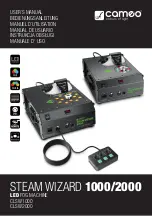
16
| English
3 609 929 C89 | (19.2.14)
Bosch Power Tools
Prevent unintentional starting. Ensure the switch is in
the off-position before connecting to power source
and/or battery pack, picking up or carrying the tool.
Carrying power tools with your finger on the switch or en-
ergising power tools that have the switch on invites acci-
dents.
Remove any adjusting key or wrench before turning
the power tool on.
A wrench or a key left attached to a ro-
tating part of the power tool may result in personal injury.
Do not overreach. Keep proper footing and balance at
all times.
This enables better control of the power tool in
unexpected situations.
Dress properly. Do not wear loose clothing or jewel-
lery. Keep your hair, clothing and gloves away from
moving parts.
Loose clothes, jewellery or long hair can be
caught in moving parts.
If devices are provided for the connection of dust ex-
traction and collection facilities, ensure these are con-
nected and properly used.
Use of dust collection can re-
duce dust-related hazards.
Power tool use and care
Do not force the power tool. Use the correct power tool
for your application.
The correct power tool will do the
job better and safer at the rate for which it was designed.
Do not use the power tool if the switch does not turn it
on and off.
Any power tool that cannot be controlled with
the switch is dangerous and must be repaired.
Disconnect the plug from the power source and/or the
battery pack from the power tool before making any
adjustments, changing accessories, or storing power
tools.
Such preventive safety measures reduce the risk of
starting the power tool accidentally.
Store idle power tools out of the reach of children and
do not allow persons unfamiliar with the power tool or
these instructions to operate the power tool.
Power
tools are dangerous in the hands of untrained users.
Maintain power tools. Check for misalignment or bind-
ing of moving parts, breakage of parts and any other
condition that may affect the power tool’s operation. If
damaged, have the power tool repaired before use.
Many accidents are caused by poorly maintained power
tools.
Keep cutting tools sharp and clean.
Properly maintained
cutting tools with sharp cutting edges are less likely to bind
and are easier to control.
Use the power tool, accessories and tool bits etc. in ac-
cordance with these instructions, taking into account
the working conditions and the work to be performed.
Use of the power tool for operations different from those
intended could result in a hazardous situation.
Service
Have your power tool serviced by a qualified repair per-
son using only identical replacement parts.
This will en-
sure that the safety of the power tool is maintained.
Cut-off machine safety warnings
The guard provided with the tool must be securely at-
tached to the power tool and positioned for maximum
safety, so the least amount of wheel is exposed to-
wards the operator. Position yourself and bystanders
away from the plane of the rotating wheel.
The guard
helps to protect operator from broken wheel fragments
and accidental contact with wheel.
Use only bonded reinforced or diamond cut-off wheels
for your power tool.
Just because an accessory can be at-
tached to your power tool, it does not assure safe opera-
tion.
The rated speed of the accessory must be at least equal
to the maximum speed marked on the power tool.
Ac-
cessories running faster than their rated speed can break
and fly apart.
Wheels must be used only for recommended applica-
tions. For example: do not grind with the side of cut-off
wheel.
Abrasive cut-off wheels are intended for peripheral
grinding, side forces applied to these wheels may cause
them to shatter.
Always use undamaged wheel flanges that are of cor-
rect diameter for your selected wheel.
Proper wheel
flanges support the wheel thus reducing the possibility of
wheel breakage.
The outside diameter and the thickness of your acces-
sory must be within the capacity rating of your power
tool.
Incorrectly sized accessories cannot be adequately
guarded or controlled.
The arbour size of wheels and flanges must properly fit
the spindle of the power tool.
Wheels and flanges with ar-
bour holes that do not match the mounting hardware of the
power tool will run out of balance, vibrate excessively and
may cause loss of control.
Do not use damaged wheels. Before each use, inspect
the wheels for chips and cracks. If power tool or wheel
is dropped, inspect for damage or install an undam-
aged wheel. After inspecting and installing the wheel,
position yourself and bystanders away from the plane
of the rotating wheel and run the power tool at maxi-
mum no load speed for one minute.
Damaged wheels will
normally break apart during this test time.
Wear personal protective equipment. Depending on
application, use face shield, safety goggles or safety
glasses. As appropriate, wear dust mask, hearing pro-
tectors, gloves and shop apron capable of stopping
small abrasive or workpiece fragments.
The eye protec-
tion must be capable of stopping flying debris generated
by various operations. The dust mask or respirator must be
capable of filtrating particles generated by your operation.
Prolonged exposure to high intensity noise may cause
hearing loss.
Keep bystanders a safe distance away from work area.
Anyone entering the work area must wear personal
protective equipment.
Fragments of workpiece or of a
broken accessory may fly away and cause injury beyond
immediate area of operation.
OBJ_BUCH-126-002.book Page 16 Wednesday, February 19, 2014 1:49 PM
















































